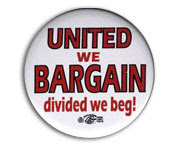

The Union Difference
· In 2008, workers in education, training, and library occupations had the highest unionization rates for any occupation group. Nearly 39% of workers in this occupation group were members of a union.[39]
· In 2008, 25.8% of librarians were union members; 30.2% were represented by unions.
· Among library technicians, 19.4% were union members in 2008, and 20.8% were represented by unions.[40]
· Twenty-seven percent of other education, training, and library workers were union members in 2008, and 31.1% were represented by unions.
· Union librarians earned an average of 29% more than non-union librarians in 2008.[Bureau of National Affairs, Union Membership and Earnings Data Book, 2009 Edition, Washington, DC.] Union library technicians earned an average of 40% more than non-union librarian technicians in 2008.
· Union other education, training, and library workers earned an average of 12% more than non-union workers.[42]
· Through the NY Public Library Guild, Local 1930, American Federation of State, County and Municipal Employees (AFSCME) library workers won an eight percent pay increase, in addition to the two four percent raises negotiated for citywide employees, after a three year campaign and negotiating with city officials.[43]
· The Orange County, Florida, Library System organized and affiliated with the Service Employees International Union (SEIU). Management spent $100,000 to defeat the union. Workers got the first pay raise in nine years as a result of bargaining, as well as an extra floating holiday and a grievance procedure that mandates binding arbitration.[44]
· Across all regions, librarians benefit from unionization. For example, the smallest gain was in the North Atlantic and Great Lakes and Plains regions where union librarians earned nearly 19% more than their fellow non-union librarians. The greatest gains were in the West and Southwest where there was a nearly 27% gain from unionization.[45]
· Across all types of work in the library profession a union advantage existed, from associate librarians who earned more than 27% more than their non-union counterparts, to library techs who earned more than 25% more than their non-union colleagues.[46]
· Almost no matter what type of institution a librarian works at there is a union advantage, be it a gain of over 62% in very small public libraries to over four percent for librarians at four-year colleges, the one employment situation that did not show a marked union advantage.[47]




No comments:
Post a Comment